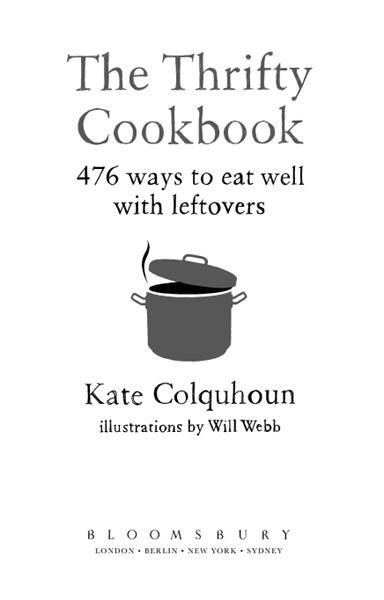


















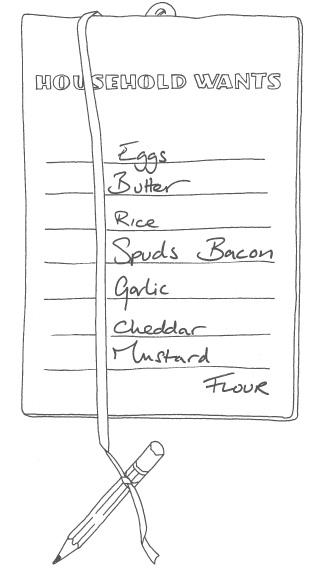

Cooking with food that you might otherwise simply throw out makes sense in all sorts of ways. Creating something tasty from languishing fruit or vegetables, extending the life of fresh meat by using marinades, preserving gluts in jams or chutneys, or simply using up a bowlful of leftover meat, rice or pasta will not only save you money but also make a substantial environmental difference.This kind of thrifty cooking is not about making an impression. Its about being relaxed without compromising on quality and taste, the kind of cooking that you simply cant be fetishistic about. This is not the place for purism or marvellous presentation. So thats a relief.The statistics of how much food we throw away are astonishing: 6.7 million tonnes a year and rising. Thats a third of all the food we buy, and enough to fill Wembley stadium to the brim eight times a year. Half of it is meat bones, teabags, eggshells and vegetable peelings but the other half could be eaten. We chuck out three times more than the total waste from supermarkets, which is not to say that the food industry and the public sector dont have much to do the food chain is still generating 11 million tonnes of waste but it does put much of the responsibility for change back on our own doorstep.We live in a world where half of us are killing ourselves with excess calories while the other half starve, in a society that spends more on dieting than on food aid and where health and safety legislation means that it is criminal to donate perfectly viable food thats reached its use-by date to the homeless. And though we might get into a lather about food miles or the ethics of battery chickens, the amount of food we send to landfill each year is the skeleton in the cupboard. Its only alarming when the bin bag breaks, disgorging its slimy contents all over the floor; the rest of the time we dont notice.There is, of course, a significant environmental cost to all this. In landfill sites, rotting food, airless in its black bags, creates methane a greenhouse gas 23 times more powerful than carbon dioxide and a poisonous black sludge that seeps into our watercourses. Its estimated that if we just stopped wasting food, we could reduce our carbon dioxide equivalent emissions by at least 15 million tonnes a year the same as taking one in every five cars off the road. This is far more than we could achieve by reducing food packaging or eliminating plastic bags.Wasting food also costs hard-earned cash something like 15,00024,000 in a lifetime and worth around 10 billion a year, which is more than the UKs foreign aid budget. Depressingly, around a quarter of it is chucked out in its original packaging: including 5,500 chickens and 1.2 million sausages, almost 4.5 million apples and only slightly fewer potatoes every day, plus around 328,000 tonnes of bread a year.As a proportion of our income, food is cheaper than it has ever been no wonder we value it less and are easily seduced into buying too much of it at once. But food prices are on the rise, driving inflation as fast as oil and gas prices. Climate variation is affecting traditional harvests around the world, while an exploding population means that our future ability to feed ourselves is in question: the UN warns that we need to increase world food production by 70% by 2050 to feed a population that will have risen from six to nine billion. So its not just about price its also about hunger. Curbing the wasteful habits of the past century is more than a middle-class lifestyle choice. Its critical.Unlike most of our Continental neighbours or families in Asia and the Middle East, who still use up their food with imagination and without embarrassment to make two, four or even more meals, weve broadly lost the knack perhaps the first generation to give up on taking leftovers and food past its best seriously. But returning to traditions of buying less, wasting less and honouring food and its production more shouldnt be difficult. Price rises will feel less burdensome if you know youre going to get several good meals out of what you buy, refusing like granny to waste a scrap.This isnt boring frugality its about making food that tastes really good think of Italy, where leftover dishes such as Ribollita, Arancini and Bread Salad or Panzanella (see ) are some of the finest in the repertoire. Theres no need to rehash the same old meat endlessly throughout the week any more than to collect the lard for greasing cartwheels. Actually, it is worth having lard around because there are times when it tastes better and works better than olive oil: roast potatoes are a case in point. But you dont have to buy it you can save the fat from a roast. Stock cubes and bouillon powders are fine, but theres something really good as well as useful about a simple home-made stock. And its virtually free. Long after its lost its right to live on the breadboard, the last bit of bread can be used in puddings, salads or soups, or kept in the freezer as breadcrumbs to use in meatballs or as the crunchy top of a bake, zesty with lemon and pungent with garlic and herbs.Cooking with leftovers in delicious, imaginative and easy ways and using up raw food that would otherwise be thrown away is a vital part of the continuum for anyone who cares about their food. I have to say that much of what follows in this book might seem like stating the bleeding obvious that fresh herbs and good spices are essential components of making food tasty; that one simple extra ingredient from a store cupboard or picked up on the way home can transform all the bits in the fridge that need to be used up; that meat thats already been cooked is not going to give up any more juices; that you can do different things with leftovers depending on how much you have to work with. But bear with me. This kind of cooking is also, often, about inverting the normal scheme of things. Instead of being seduced by a new recipe and then rushing out to get the ingredients, youll be looking at what you have to hand and then deciding what kind of taste and texture you want and what kind of cooking youre in the mood for: a soup, pie or stir-fry, a salad, stew or bake? Sometimes as with meat in stir-fries the method will completely reverse the usual way of doing things and, except when you are making pastry or baking cakes, precise measures are not going to matter.In some ways, recipes themselves are suspect, because this is all about practicality and imagination. Most of these recipes work on rough amounts a British teacupful (about 175ml) of meat per person, say, for a pie and they describe basic processes that can be endlessly varied, with lots of ideas on how you can change things about. Meat, for example, can be omitted from almost any recipe and replaced with vegetables that are crying out to be used up. To help get you started, Ive included a basic list of the kind of flavours that go together well (see ). The knack is to taste and taste again as you cook, altering the combinations of herbs and seasonings and developing the recipe ideas in the pages that follow to suit your own style.Thrifty cooking is not about bland and colourless dinners for the sake of saving a chicken wing. With fresh cream in just about every corner shop, olive oil on every shelf and inspiration flooding in from all corners of the globe, there need be nothing plain about this food nothing stopping it from being as good (or better) than it was the first time around. I bet most of us have got the Christmas leftover thing taped through sheer force of practice, and this book is really just an extension of that. With a bit of planning, a thoughtful array of cupboard staples, judicious use of space in the freezer and experimentation with what goes with what, using up food properly can become something of an addictive habit. The last carrots in the fridge can be transformed into a curried pickle that will enliven a basic pilaf, a couple of blackened bananas make a lush banana cake, while a lingering single egg white is easily whisked into a meringue that will keep in a tin for weeks, if youve got that kind of self-control. Taking these recipes as a guide, you can eke out several good meals from one big roast conjuring free food out of what, yesterday, you might have considered rubbish.These are ideas you can play with, alter and refine according to your own taste; they are quick and unfussy, requiring very little preparation and producing even less washing up. Using up food you might otherwise chuck means you are doing your bit for sustainability, and it should leave you with more cash in your pocket, more space in your fridge and a welcome reconnection with your kitchen. Cheap to the point of being free, its not just about common sense it is tasty and infinitely, almost smugly, rewarding. And, yes, it could even help change your world.
Next page
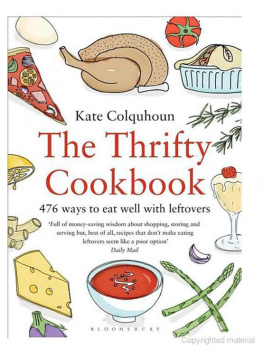
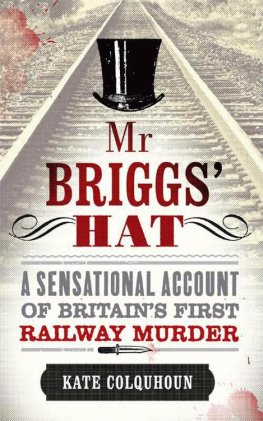


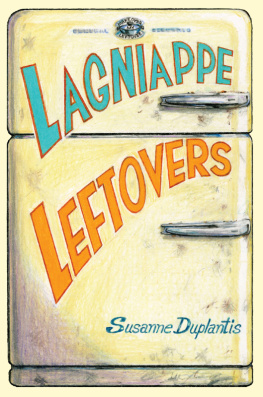
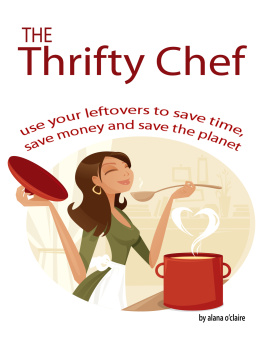
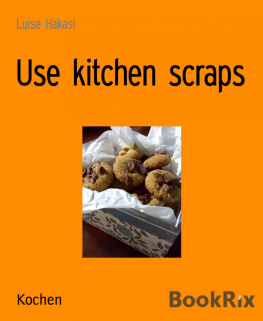

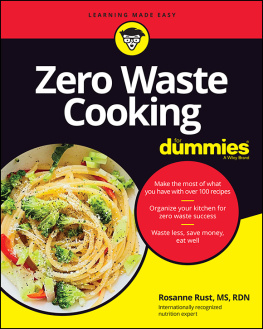
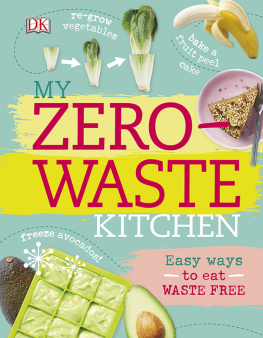
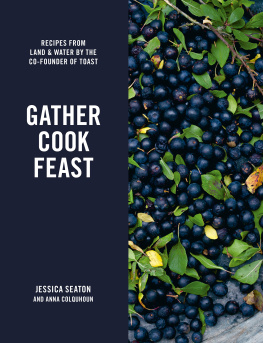

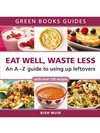
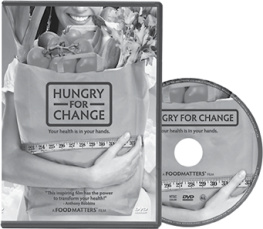




















 Cooking with food that you might otherwise simply throw out makes sense in all sorts of ways. Creating something tasty from languishing fruit or vegetables, extending the life of fresh meat by using marinades, preserving gluts in jams or chutneys, or simply using up a bowlful of leftover meat, rice or pasta will not only save you money but also make a substantial environmental difference.This kind of thrifty cooking is not about making an impression. Its about being relaxed without compromising on quality and taste, the kind of cooking that you simply cant be fetishistic about. This is not the place for purism or marvellous presentation. So thats a relief.The statistics of how much food we throw away are astonishing: 6.7 million tonnes a year and rising. Thats a third of all the food we buy, and enough to fill Wembley stadium to the brim eight times a year. Half of it is meat bones, teabags, eggshells and vegetable peelings but the other half could be eaten. We chuck out three times more than the total waste from supermarkets, which is not to say that the food industry and the public sector dont have much to do the food chain is still generating 11 million tonnes of waste but it does put much of the responsibility for change back on our own doorstep.We live in a world where half of us are killing ourselves with excess calories while the other half starve, in a society that spends more on dieting than on food aid and where health and safety legislation means that it is criminal to donate perfectly viable food thats reached its use-by date to the homeless. And though we might get into a lather about food miles or the ethics of battery chickens, the amount of food we send to landfill each year is the skeleton in the cupboard. Its only alarming when the bin bag breaks, disgorging its slimy contents all over the floor; the rest of the time we dont notice.There is, of course, a significant environmental cost to all this. In landfill sites, rotting food, airless in its black bags, creates methane a greenhouse gas 23 times more powerful than carbon dioxide and a poisonous black sludge that seeps into our watercourses. Its estimated that if we just stopped wasting food, we could reduce our carbon dioxide equivalent emissions by at least 15 million tonnes a year the same as taking one in every five cars off the road. This is far more than we could achieve by reducing food packaging or eliminating plastic bags.Wasting food also costs hard-earned cash something like 15,00024,000 in a lifetime and worth around 10 billion a year, which is more than the UKs foreign aid budget. Depressingly, around a quarter of it is chucked out in its original packaging: including 5,500 chickens and 1.2 million sausages, almost 4.5 million apples and only slightly fewer potatoes every day, plus around 328,000 tonnes of bread a year.As a proportion of our income, food is cheaper than it has ever been no wonder we value it less and are easily seduced into buying too much of it at once. But food prices are on the rise, driving inflation as fast as oil and gas prices. Climate variation is affecting traditional harvests around the world, while an exploding population means that our future ability to feed ourselves is in question: the UN warns that we need to increase world food production by 70% by 2050 to feed a population that will have risen from six to nine billion. So its not just about price its also about hunger. Curbing the wasteful habits of the past century is more than a middle-class lifestyle choice. Its critical.Unlike most of our Continental neighbours or families in Asia and the Middle East, who still use up their food with imagination and without embarrassment to make two, four or even more meals, weve broadly lost the knack perhaps the first generation to give up on taking leftovers and food past its best seriously. But returning to traditions of buying less, wasting less and honouring food and its production more shouldnt be difficult. Price rises will feel less burdensome if you know youre going to get several good meals out of what you buy, refusing like granny to waste a scrap.This isnt boring frugality its about making food that tastes really good think of Italy, where leftover dishes such as Ribollita, Arancini and Bread Salad or Panzanella (see ) are some of the finest in the repertoire. Theres no need to rehash the same old meat endlessly throughout the week any more than to collect the lard for greasing cartwheels. Actually, it is worth having lard around because there are times when it tastes better and works better than olive oil: roast potatoes are a case in point. But you dont have to buy it you can save the fat from a roast. Stock cubes and bouillon powders are fine, but theres something really good as well as useful about a simple home-made stock. And its virtually free. Long after its lost its right to live on the breadboard, the last bit of bread can be used in puddings, salads or soups, or kept in the freezer as breadcrumbs to use in meatballs or as the crunchy top of a bake, zesty with lemon and pungent with garlic and herbs.Cooking with leftovers in delicious, imaginative and easy ways and using up raw food that would otherwise be thrown away is a vital part of the continuum for anyone who cares about their food. I have to say that much of what follows in this book might seem like stating the bleeding obvious that fresh herbs and good spices are essential components of making food tasty; that one simple extra ingredient from a store cupboard or picked up on the way home can transform all the bits in the fridge that need to be used up; that meat thats already been cooked is not going to give up any more juices; that you can do different things with leftovers depending on how much you have to work with. But bear with me. This kind of cooking is also, often, about inverting the normal scheme of things. Instead of being seduced by a new recipe and then rushing out to get the ingredients, youll be looking at what you have to hand and then deciding what kind of taste and texture you want and what kind of cooking youre in the mood for: a soup, pie or stir-fry, a salad, stew or bake? Sometimes as with meat in stir-fries the method will completely reverse the usual way of doing things and, except when you are making pastry or baking cakes, precise measures are not going to matter.In some ways, recipes themselves are suspect, because this is all about practicality and imagination. Most of these recipes work on rough amounts a British teacupful (about 175ml) of meat per person, say, for a pie and they describe basic processes that can be endlessly varied, with lots of ideas on how you can change things about. Meat, for example, can be omitted from almost any recipe and replaced with vegetables that are crying out to be used up. To help get you started, Ive included a basic list of the kind of flavours that go together well (see ). The knack is to taste and taste again as you cook, altering the combinations of herbs and seasonings and developing the recipe ideas in the pages that follow to suit your own style.Thrifty cooking is not about bland and colourless dinners for the sake of saving a chicken wing. With fresh cream in just about every corner shop, olive oil on every shelf and inspiration flooding in from all corners of the globe, there need be nothing plain about this food nothing stopping it from being as good (or better) than it was the first time around. I bet most of us have got the Christmas leftover thing taped through sheer force of practice, and this book is really just an extension of that. With a bit of planning, a thoughtful array of cupboard staples, judicious use of space in the freezer and experimentation with what goes with what, using up food properly can become something of an addictive habit. The last carrots in the fridge can be transformed into a curried pickle that will enliven a basic pilaf, a couple of blackened bananas make a lush banana cake, while a lingering single egg white is easily whisked into a meringue that will keep in a tin for weeks, if youve got that kind of self-control. Taking these recipes as a guide, you can eke out several good meals from one big roast conjuring free food out of what, yesterday, you might have considered rubbish.These are ideas you can play with, alter and refine according to your own taste; they are quick and unfussy, requiring very little preparation and producing even less washing up. Using up food you might otherwise chuck means you are doing your bit for sustainability, and it should leave you with more cash in your pocket, more space in your fridge and a welcome reconnection with your kitchen. Cheap to the point of being free, its not just about common sense it is tasty and infinitely, almost smugly, rewarding. And, yes, it could even help change your world.
Cooking with food that you might otherwise simply throw out makes sense in all sorts of ways. Creating something tasty from languishing fruit or vegetables, extending the life of fresh meat by using marinades, preserving gluts in jams or chutneys, or simply using up a bowlful of leftover meat, rice or pasta will not only save you money but also make a substantial environmental difference.This kind of thrifty cooking is not about making an impression. Its about being relaxed without compromising on quality and taste, the kind of cooking that you simply cant be fetishistic about. This is not the place for purism or marvellous presentation. So thats a relief.The statistics of how much food we throw away are astonishing: 6.7 million tonnes a year and rising. Thats a third of all the food we buy, and enough to fill Wembley stadium to the brim eight times a year. Half of it is meat bones, teabags, eggshells and vegetable peelings but the other half could be eaten. We chuck out three times more than the total waste from supermarkets, which is not to say that the food industry and the public sector dont have much to do the food chain is still generating 11 million tonnes of waste but it does put much of the responsibility for change back on our own doorstep.We live in a world where half of us are killing ourselves with excess calories while the other half starve, in a society that spends more on dieting than on food aid and where health and safety legislation means that it is criminal to donate perfectly viable food thats reached its use-by date to the homeless. And though we might get into a lather about food miles or the ethics of battery chickens, the amount of food we send to landfill each year is the skeleton in the cupboard. Its only alarming when the bin bag breaks, disgorging its slimy contents all over the floor; the rest of the time we dont notice.There is, of course, a significant environmental cost to all this. In landfill sites, rotting food, airless in its black bags, creates methane a greenhouse gas 23 times more powerful than carbon dioxide and a poisonous black sludge that seeps into our watercourses. Its estimated that if we just stopped wasting food, we could reduce our carbon dioxide equivalent emissions by at least 15 million tonnes a year the same as taking one in every five cars off the road. This is far more than we could achieve by reducing food packaging or eliminating plastic bags.Wasting food also costs hard-earned cash something like 15,00024,000 in a lifetime and worth around 10 billion a year, which is more than the UKs foreign aid budget. Depressingly, around a quarter of it is chucked out in its original packaging: including 5,500 chickens and 1.2 million sausages, almost 4.5 million apples and only slightly fewer potatoes every day, plus around 328,000 tonnes of bread a year.As a proportion of our income, food is cheaper than it has ever been no wonder we value it less and are easily seduced into buying too much of it at once. But food prices are on the rise, driving inflation as fast as oil and gas prices. Climate variation is affecting traditional harvests around the world, while an exploding population means that our future ability to feed ourselves is in question: the UN warns that we need to increase world food production by 70% by 2050 to feed a population that will have risen from six to nine billion. So its not just about price its also about hunger. Curbing the wasteful habits of the past century is more than a middle-class lifestyle choice. Its critical.Unlike most of our Continental neighbours or families in Asia and the Middle East, who still use up their food with imagination and without embarrassment to make two, four or even more meals, weve broadly lost the knack perhaps the first generation to give up on taking leftovers and food past its best seriously. But returning to traditions of buying less, wasting less and honouring food and its production more shouldnt be difficult. Price rises will feel less burdensome if you know youre going to get several good meals out of what you buy, refusing like granny to waste a scrap.This isnt boring frugality its about making food that tastes really good think of Italy, where leftover dishes such as Ribollita, Arancini and Bread Salad or Panzanella (see ) are some of the finest in the repertoire. Theres no need to rehash the same old meat endlessly throughout the week any more than to collect the lard for greasing cartwheels. Actually, it is worth having lard around because there are times when it tastes better and works better than olive oil: roast potatoes are a case in point. But you dont have to buy it you can save the fat from a roast. Stock cubes and bouillon powders are fine, but theres something really good as well as useful about a simple home-made stock. And its virtually free. Long after its lost its right to live on the breadboard, the last bit of bread can be used in puddings, salads or soups, or kept in the freezer as breadcrumbs to use in meatballs or as the crunchy top of a bake, zesty with lemon and pungent with garlic and herbs.Cooking with leftovers in delicious, imaginative and easy ways and using up raw food that would otherwise be thrown away is a vital part of the continuum for anyone who cares about their food. I have to say that much of what follows in this book might seem like stating the bleeding obvious that fresh herbs and good spices are essential components of making food tasty; that one simple extra ingredient from a store cupboard or picked up on the way home can transform all the bits in the fridge that need to be used up; that meat thats already been cooked is not going to give up any more juices; that you can do different things with leftovers depending on how much you have to work with. But bear with me. This kind of cooking is also, often, about inverting the normal scheme of things. Instead of being seduced by a new recipe and then rushing out to get the ingredients, youll be looking at what you have to hand and then deciding what kind of taste and texture you want and what kind of cooking youre in the mood for: a soup, pie or stir-fry, a salad, stew or bake? Sometimes as with meat in stir-fries the method will completely reverse the usual way of doing things and, except when you are making pastry or baking cakes, precise measures are not going to matter.In some ways, recipes themselves are suspect, because this is all about practicality and imagination. Most of these recipes work on rough amounts a British teacupful (about 175ml) of meat per person, say, for a pie and they describe basic processes that can be endlessly varied, with lots of ideas on how you can change things about. Meat, for example, can be omitted from almost any recipe and replaced with vegetables that are crying out to be used up. To help get you started, Ive included a basic list of the kind of flavours that go together well (see ). The knack is to taste and taste again as you cook, altering the combinations of herbs and seasonings and developing the recipe ideas in the pages that follow to suit your own style.Thrifty cooking is not about bland and colourless dinners for the sake of saving a chicken wing. With fresh cream in just about every corner shop, olive oil on every shelf and inspiration flooding in from all corners of the globe, there need be nothing plain about this food nothing stopping it from being as good (or better) than it was the first time around. I bet most of us have got the Christmas leftover thing taped through sheer force of practice, and this book is really just an extension of that. With a bit of planning, a thoughtful array of cupboard staples, judicious use of space in the freezer and experimentation with what goes with what, using up food properly can become something of an addictive habit. The last carrots in the fridge can be transformed into a curried pickle that will enliven a basic pilaf, a couple of blackened bananas make a lush banana cake, while a lingering single egg white is easily whisked into a meringue that will keep in a tin for weeks, if youve got that kind of self-control. Taking these recipes as a guide, you can eke out several good meals from one big roast conjuring free food out of what, yesterday, you might have considered rubbish.These are ideas you can play with, alter and refine according to your own taste; they are quick and unfussy, requiring very little preparation and producing even less washing up. Using up food you might otherwise chuck means you are doing your bit for sustainability, and it should leave you with more cash in your pocket, more space in your fridge and a welcome reconnection with your kitchen. Cheap to the point of being free, its not just about common sense it is tasty and infinitely, almost smugly, rewarding. And, yes, it could even help change your world.